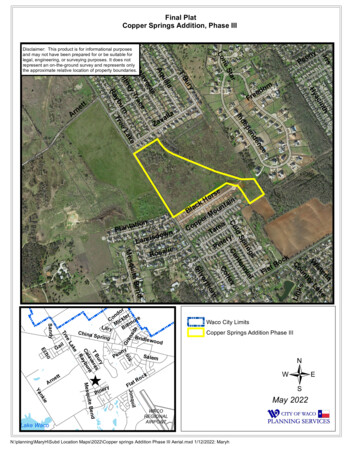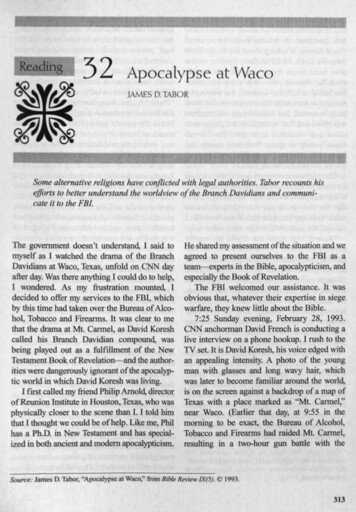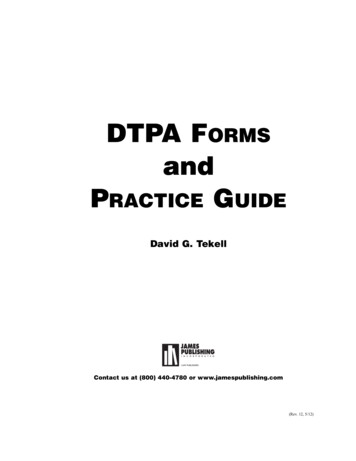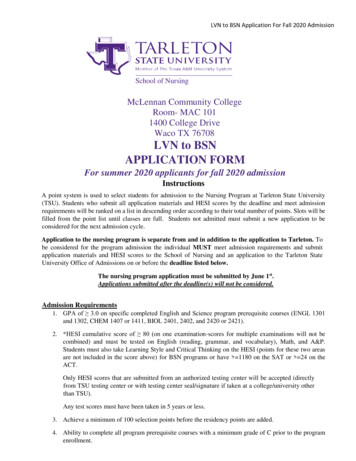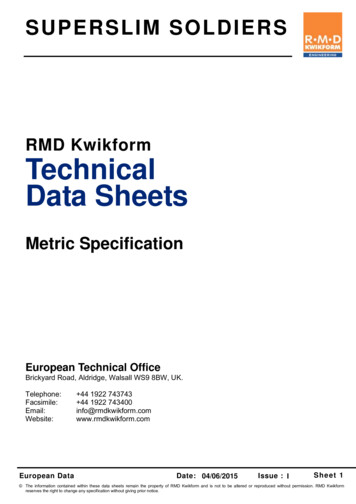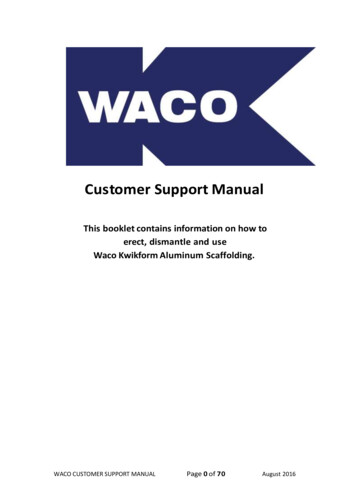
Transcription
Customer Support ManualThis booklet contains information on how toerect, dismantle and useWaco Kwikform Aluminum Scaffolding.WACO CUSTOMER SUPPORT MANUALPage 0 of 70August 2016
IndexSafetyInformationPage Number .2Competency / Work Practices . 3Risk Assessment / Planning / Preparation . .4Risk Assessment Table . .5Before commencing to erect the Scaffold .6Before using the Scaffold 6 7Care of the Scaffold .8Correct Installation for Horizontal Braces/Guardrails 9Transportation9Using the ScaffoldStorageAssembly . Instructions 910SAFE ASSEMBLY for 0.7m wide towers 11Dismantling of 0.7m wide tower guideline 20SAFE ASSEMBLY for 1.3m wide towers 21Dismantling of 1.3m wide tower guideline 32SAFE ASSEMBLY for 2.0m wide towers 33Dismantling of 2.0m wide tower guideline 44Ladder Installation Options44Toeboard InstallationOutriggers 45 46Information .47Maximum Freestanding Tower Height 48Maximum Load Ratings 49Tower Configurations, Component Lists 50Aluminium Scaffold Towers - 0.7m wide . 51Aluminium Scaffold Towers - 1.3m wide . 55Aluminium Scaffold Towers - 1.9m wide . 58TechnicalProductInformation . 60ContactDetails66 . .WACO KWIKFORM CUSTOMER SUPPORTMANUALPage 1 of 70August 2016
SAFETY INFORMATIONWACO KWIKFORM CUSTOMER SUPPORTMANUALPage 2 of 70August 2016
Competency / Work PracticesScaffolding is to be used in accordance with current Australian and New Zealand standards, Worksafe or OH& S/WHS requirements and codes of practice. Scaffolding is to be erected in accordance with suppliersrequirements, acceptable safe work practices and appropriate control measures including personalprotective equipment.For safe and efficient erection, alteration and dismantling of scaffolding, you must:Know the basic relevant rules of mechanics.Be able to understand the suppliers information, general site plans and specifications for scaffolds. (An abilityto make simple calculations of dead load and live load is often needed.)Have a thorough knowledge of the scaffolding equipment being used.Have a thorough knowledge of the construction methods and design requirements associated with theequipment.Be able to recognise hazards at the worksite and implement appropriate controls to avoid risks to health andsafetyVisually inspect scaffolding for faults, safety and compliance with design and statutory requirements, codes ofpractice and guidelines.Have the physical skills needed for scaffolding construction.Be competent in manual lifting techniques.Work safely and confidently at heights.Correctly use the various tools.Erect and dismantle scaffolding in the correct sequence.DO NOT erect, alter, dismantle or access a scaffold if you are tired or under the influence of alcohol or drugsCarefulness, common-sense and caution are factors that cannot be built into scaffolding. These mustbe provided by the user of the equipment.WACO KWIKFORM CUSTOMER SUPPORTMANUALPage 3 of 70August 2016
Risk Assessment/Planning/PreparationBefore commencing any work involving scaffolding at your chosen work area, plan aheadand be prepared. Ideally more than one person should do this. Seek expert advice ifrequired. Always ensure that you understand and can comply with the regulations thatapply to the erection and use of scaffolding in the area that you intend using thisequipment. Conduct an inspection of the worksiteConsult with other workers or those that might be affected by the work intendedEnsure you have fully read and understood the instructions providedReview relevant local legislative requirementsIdentify Hazards – Find out what could cause harmAssess the risks – Understand the nature of the harm that could be caused by thehazard, how serious the harm could be and the likelihood of it happeningControl the risks- implement the most effective control measure(s)Review control measures to ensure they are working as planned.Determine if the situation requires Certified Scaffolders to erect the Scaffold (i.e.can a person or object fall more than 4m, including potential falls through anypenetration or over any retaining wall, edge of floor etc.). All other scaffolds to beerected altered and dismantled by a competent person.Check that the surface is adequate for the point loads due to castors andoutriggers (up to 500kg). Sole boards (minimum 500mm x 200mm x 38mm –subject to ground conditions) may be required on soft groundAssess the intended travel path for safe movement of a Mobile Scaffold. Developcontrols to avoid accidents. Remember to check;o Overhead power and service Lineso Underground services, floor penetrations etc.o Uneven or unstable groundo Treeso Floor Loading Limitso Other workers, general public, animals in the vicinityo Surrounding Buildings, structures, vessels, equipment, vehicular traffic,cranes etc.o Corrosive substances and hazardous materialso Barricadeso Inadequate lightingo Any wet conditions likely to make the ground or any part of the scaffoldslipperyo Dynamic loadings such as concrete pump lineso Moving plant (e.g. excavators)o Any other likely adverse situation (e.g. weather deterioration).When working in a public area, ensure sufficient public protection has beenprovidedALWAYS ENSURE THAT YOU UNDERSTAND AND CAN COMPLY WITH THE REGULATIONSTHAT APPLY TO THE ERECTION AND USE OF SCAFFOLDING IN THE AREA THAT YOUINTEND USING THIS EQUIPMENT.WACO KWIKFORM CUSTOMER SUPPORTMANUALPage 4 of 70August 2016
Risk Assessment TableExamples of significant hazards/risks and appropriate control measures include but are not limited to, the following;Serious Hazard Identified &Possible RiskUnstable Scaffold risk of: Collapsed ScaffoldPower lines .of : ElectrocutionriskWorking at Height .of :Falling from ScaffoldriskControl MeasuresAssembly instructions must be strictly adhered to. All Scaffoldsfrom which a person or object could fall more than 4m, must beerected by a licensed scaffolderCheck supporting surface is firm and adequate to support thescaffoldEnsure scaffold is erected plumb and level.Outriggers or ties to be fitted where required. – Refer maximumheight table page 45 & Outriggers page 44Do not use Scaffold within 4.0m of overhead electric wires. Somesituations may require up to 8.0m clearance. Check with theappropriate Electrical Supply Authority. Always look up and checkbefore moving scaffold.Guardrails and mid rails must be used on all Platforms over 2mhigh* - Refer note (below)Do not ride on Scaffold whilst it is being moved.Always ensure the horizontal (yellow) braces are clipped to theinside of the standards.Do not stand or sit on midrails or Guardrails.Do not use a ladder or steps to gain extra height when working onscaffold platforms.Internal ladders only are to be fitted to scaffold for access. Do notclimb on inside or outside of scaffold framework.Use only the internal ladders provided for access.Material falling from Scaffold .risk of :Injury or damagebelowToeboards must be fitted at all Platforms over 2m* in height. (*some states require all heights) Ensure there are no gaps.Platforms to be clear of materials when mobile scaffold is beingmoved.Castors on mobile Scaffolds must have brakes which must beSloping Ground .applied when Scaffold is in use.risk of : Unstable ScaffoldDo not use mobile Scaffold on any surface that slopes more than 5degrees unless provision is made to take the load off the castorsduring use of the scaffold.Do not fit containment sheeting, banners or similar to scaffold.Wind, Horizontal loading Tie scaffold to solid structure, AND fit outriggers to lowerrisk of : Overturning of scaffoldheight towers Where adverse weather conditions are expected, windsexceeding 32kph Where the scaffold is located in a wind funneling location,between large buildings, or open exposed buildings Where the nature of work is applying horizontal forces atthe working deck, e.g. drilling. When the tower is to be left unattended for any time,especially in areas of public access*Note: the 2m platform height relates to the distance a person or object could fall from the platform.Edge protection may be required at lower heights/ all heights - check your local requirements. (Note:New Zealand requests edge protection is provided for platforms at all heights unless a full written riskassessment has been carried out that prove no risk of harm exists.)WACO KWIKFORM CUSTOMER SUPPORTMANUALPage 5 of 70August 2016
Before commencing to erect the Scaffold Ensure the suppliers instruction document is read and understood. Ensurethe scaffold is erected in accordance with this manual.Inspect all components, and, where required replace damagedcomponents. DO NOT use damaged or incompatible componentsSort and separate like components. DO NOT mix and match componentsfrom other systemsEnsure unauthorised persons are prevented from accessing the area wherethe scaffold is to be erected and used.Ensure you have any relevant permits required for working at height onyour particular site.Before using the Scaffold Ensure the Scaffold Tower is plumb and level. Check that the surface is adequate for the point loads due to castors andoutriggers (up to 500kg). Sole boards (minimum 500mm x 200mm x38mm – subject to ground conditions) may be required on soft ground. Check all Diagonal, Horizontal and Plan braces are installed, and that thewhole configuration is deviate, and use only original components. Check that Ladder access is available to every platform. Check that Outriggers are fitted as required –refer Fitting Outriggers (page44) Check all platform levels have correctly fitted edge protection(Guardrails/midrails/toe boards) to each deck over 2m* in height , (* somestates require all heights) If mobile, check that all Castor brakes are locked on. Check and assess the Scaffold at the start of each day/ use. If it has anydamage or defects, do not use the Scaffold but alert the supplier orperson(s) controlling the Scaffold. Ensure access to incomplete scaffold is closed and warning signs placed.WACO KWIKFORM CUSTOMER SUPPORTMANUALPage 6 of 70August 2016
Using the Scaffold Ensure the Scaffold is never used for purposes that it was not designed to be usedfor.Ensure there are no persons or objects on the Scaffold whilst it is being moved.Always reapply all Castor Brakes and re-level the Scaffold after moving.Do not overload / exceed the specified safe working load of the Scaffold. –Refer toMaximum Load ratings (page46)Never use ladders or any sort of device to gain additional height above a Scaffoldplatform.Never use or attach Hoisting equipment to the ScaffoldDo not allow any part of the Scaffold to come within 4.0m of overhead powerlines. Some lines may require up to 8m clearance, check with the appropriatepower authority before approaching the wires.Do not use the Scaffold if you are tired, suffering any medical condition, or underthe influence of alcohol or drugs which may cause lethargy or danger to yourselfor others.Ensure the mobile scaffold is protected against impact from moving plant/ vehiclesEnsure unattended scaffold is secure and access by unauthorised persons ispreventedDo not use the Scaffold in extreme weather, or high winds. Scaffold should beanchored/secured to resist winds that are above 32kph.If in exposed or elevated area, secure the scaffold to a fixed structure (to preventoverturning), and tie down platforms, (to prevent dislodgement).Be aware of situations where winds are magnified by funnelling effects e.g. at corners ofbuildings or between tall buildings.Never attach tarpaulins or other coverings to the scaffold as this may seriously increase itssusceptibility to wind force.Simple wind chart below, for identifying wind hazard, as a guideline only. Not to overwritesite safety procedures.WindDescriptionSpeed(kph)Visible IndicationsAction RequiredMedium breeze20 - 29Raises dust and loose paper, smallbranches move on trees.Safe to work on tower.Fresh breeze30 - 39Small trees in leaf begin to sway.Ensure that the tower is tied to arigid structure & has outriggersfittedStrong breeze40 - 50Large branches in motion, umbrella’s usewith difficulty, telegraph wires whistle.Cease to work on tower andensure any loose platforms aretied down.Twigs break off tree, progress generallyimpeded.Dismantle tower if storms forecast.Gale Force60 WACO KWIKFORM CUSTOMER SUPPORTMANUALPage 7 of 70August 2016
Care of the Scaffold Take good care of the scaffold, components should fit together easilywithout using force. Keep equipment, specially joints and moving partsclean. Care to be taken when dismantling scaffold, never let components drop orfall to the ground as the impact could cause structural damage. Never modify or alter the Scaffold or its components in any way. Only persons authorized by the supplier are permitted to carry out repairs. Only original parts are to be used when replacing any parts of any WacoKwikform Scaffold components. Any damaged component must be reported to the person responsible forthe supply of the Scaffold immediately. If scaffold is being used for an extended period in a corrosive environment,apply a lubricating spray to all brace grasper pins/ springs and checkregularly to ensure they move freely, & do not become stiff or seized. Do not use Components if;oooooooGraspers, Brace ends are looseGraspers do not engage correctly (stiff or seized)Ladder stand off arm does not operate correctlyAluminium components are dented, deformed or crackedCastor wheels do not rotate freelyCastor or screw jack adjustment nuts do not rotate freelyCastor Brakes do not unlock or lockWACO KWIKFORM CUSTOMER SUPPORTMANUALPage 8 of 70August 2016
Correct Installation for Horizontal Braces/GuardrailsDo not step on Horizontal Braces when accessing the scaffold.Please do not stand or sit on midrails or guardrails.Make sure the horizontals braces (yellow) are always clipped to the INSIDE of the standards.Misuse by dropping from height or throwing onto the back of vehicles for example can damage the ends ofgraspers. Fittings should be regularly inspected and any damaged fitting should be replaced.Further, if the grasper becomes closed or extended in any way for any reason it is to be discarded.Do not use scaffold with damaged or missing component. Contact your Scaffold supplier for a replacement.TransportationAll loads must be securely fastened as slippage occurs with aluminium components.StorageStack equipment securely to prevent falling.Equipment is best stacked away from corrosive materials.If stored indoors stack one on top of each other and outdoors store upright to allow moisture to run off.Avoid leaving plywood components (Platforms and Toe boards) in long term storage exposed to all weathers,as excessive moisture and sunlight/heat can cause ply deterioration.WACO KWIKFORM CUSTOMER SUPPORTMANUALPage 9 of 70August 2016
ASSEMBLY INSTRUCTIONSWACO KWIKFORM CUSTOMER SUPPORTMANUALPage 10 of 70August 2016
SAFE ASSEMBLY for 0.7m wide Waco Kwikform TowersAlways ensure you understand and can meet the compliance requirements that apply to the erection and useof scaffolding in the location where the equipment will be used.Step 1Lock brakes on Castors and insert into 1st Base Frame. Attach 2 Horizontal Braces (yellow ends) to INSIDE(diagram 1b) of standards (vertical member) above bottom Rung (horizontal member). See Diagram 1a below.1a1bHorizontal Brace (yellowends) attached to INSIDEof standardStep 2Lock brakes on Castors and insert into second Base Frame. Attach Horizontal Braces to INSIDE of standards,use threaded adjuster to approximately level scaffold. See diagram 2a2aCastors with threaded adjuster forlevelling, or fine tuning tower height.Ensure Castor is locked to the BaseFrame after each adjustment with thelocking bolt or screw tightened to theframe. IMPORTANT: Always leavebrakes applied unless moving towerWACO KWIKFORM CUSTOMER SUPPORTMANUALPage 11 of 70August 2016
Step 3Install Diagonal Brace (silver) from bottom Rung, to third Rung up (2 spaces). This should be fitted in as closeas practical to the inside of the frame. Check scaffold is level in each direction, and adjust using heightadjustable Castors.3aDiagonal Brace (silverends) fitted from baserung to 3rd.Step 4Install 2 Horizontal Braces to the top rung of Base Frame, as a temporary guardrail.4aHorizontal Braces(acting as temporaryguardrail)WACO KWIKFORM CUSTOMER SUPPORTMANUALPage 12 of 70August 2016
Step 5Install an Access Platform in temporary position to 2nd rung of Base Frame.5aAccess PlatformStep 6Standing on temporary platformInstall 2 Upper FramesUpper Frames withmale spigots facingdown. Inserts intoframe below6aHorizontal Braces(acting as temporaryguardrail)WACO KWIKFORM CUSTOMER SUPPORTMANUALPage 13 of 70August 2016
Step 7Standing on temporary platformFit 4 x Horizontal Braces as guardrails and Midrails for next deck (Diagram 7a.)Fit Diagonal Brace, fit in opposite direction to Diagonal brace below (diagram 7b)Fit Outriggers as required (Diagram 7c .Note: 0.7m wide towers require Outriggers for platform heights of1.4m or more)Fit Diagonal Brace (diagram 7b)7bDiagonal Brace fitted inopposite direction fromtop rung of frame below Temporary platform(standing position)7c Fit Outriggers as requiredOUTRIGGER INSTALLATION“NOTE wall omitted for clarity”Where the scaffold is erected alongsidea solid structure (eg a wall), twooutriggers are required; fitted on theside opposite the wall. Otherwise 4Outriggers are required; fitted to eachcorner of the scaffold.Top of Outrigger can be safely securedby standing on Temporary platform.Attach Outrigger standoff arm to baseframe. For details of when outriggersare required refer to; Fitting Outriggers (pg44) Maximum Freestanding TowerHeight (Pg45)Risk Assessment Table (Pg4)WACO KWIKFORM CUSTOMER SUPPORTMANUALPage 14 of 70August 2016
Step 8Standing on Ground,Remove Horizontal braces acting as a temporary guardrail from top rung of Base frame. (diagram 8a)Move temporary platform up to form full deck on top rung of base frame. (diagram 8b)Install ladder to the top rung of the Base Frame at the end of the access hatch (diagram 8c)8a8bRemove Horizontaltemporary guardrailMoveTemporaryplatform upto form fulldeck.RemoveFrom hereTo this level8cInstall ladder to the top rung of the Base Frame at the end of the access hatch.Ladder placed inline with AccessHatchWACO KWIKFORM CUSTOMER SUPPORTMANUALPage 15 of 70August 2016
Fit toe board setTake care installing Toeboard sets. EnsureHinge nuts faceOUTWARDS.Hint. Place toe boardson deck while insertinginto male hinge pin ofend board. Oncesecured in end boardthe other end can belifted into opposite endboard and placed intoposition. More detailavailable on page 43Steps 10.You have now completed a full working platform.Repeat steps 4-9 for each additionalplatform level, as follows.10a. Standing on Full working platform*Install 2 Horizontal Braces (acting as temporary guardrails) to top (4th) rung above working deck (diagram10.4)Install 2nd Access Platform in temporary position, 2 rungs above the working platform you’re standing onEnsure Access Hatch is at opposite end, of tower to the one below.Hint: Open hatch and stand through the platform for ergonomic handling (diagram10.5).510.42nd Access Platformin temporarypositionWACO KWIKFORM CUSTOMER SUPPORTMANUALPage 16 of 70August 2016
*Ensure the access Hatch is closed at all times when standing/working on any access platform10b. Standing on 2nd Temporary platform*Install upper frames required. This example shows 2 Rung Frames being installed for Guardrails of topworking deck. (Diagram 10.6)Fit 4 x Horizontal Braces as guardrails and Midrails for next deck (diagram 10.7a)Fit Diagonal Brace, fit in opposite direction to Diagonal brace below (diagram 10.7b)10.62nd Temporaryplatform(standingposition)*Horizontal Braces(acting as temporaryguardrail)10.7a4 x HorizontalBraces asguardrails andmidrailsWACO KWIKFORM CUSTOMER SUPPORT MANUAL10.7bDiagonal Bracefitted in oppositedirection fromtop rung offrame belowPage 17 of 70 August 2016
*Ensure the access Hatch is closed at all times when standing/working on any access platform10c. Standing on 2nd Temporary platform*Unclip Horizontal braces acting as temporary guardrails above 2nd Platform only at the end away from theaccess hatch, leaving the graspers resting on the rung inside the standard. (Diagram 10.8a) The graspersabove the access hatch remain attached.Hint: If a diagonal grasper is in the way, release and lift that out of the way, release the horizontal grasper and pull itback to rest on the rung on the inside of where diagonal grasper is fitted, and refit the diagonal grasper.10.8aRemoving HorizontalBraces acting astemporary guardrail.Step 1.10d. Standing on 1st working platform* through access hatch of 2nd temporary platformRemove Horizontal braces acting as a temporary guardrail from 2nd rung above temporary platform.(diagram10.8b) Hint: if this is the final or top platform position, place the Horizontal Braces down one rung to store, ready to beused for dismantling the tower.Move temporary platform up to form full deck on 4th rung above existing working platform. (diagram 10.8b)Install ladder at the end of the access hatch (diagram 10.8c)10.8bMoveTemporaryplatform up toform full deck.From hereTo this levelStanding position toremove temporaryguardrails and move upaccess platformWACO KWIKFORM CUSTOMER SUPPORTMANUALPage 18 of 70August 2016
*Ensure the access Hatch is closed at all times when standing/working on any access platform10.8 c Standing on 1st working platformLadder placed inline with AccessHatch10e. Standing on 2nd (top)platform*Fit toe board set (diagram 10.9)Take care installing Toeboard sets. EnsureHinge nuts faceOUTWARDS.10.9Hint. Place toe boardson deck while insertinginto male hinge pin ofend board. Oncesecured in end boardthe other end can belifted into opposite endboard and placed intoposition. More detailavailable on page 43*Ensure the access Hatch is closed at all times when standing/working on any access platformCarefulness, common-sense and caution are factors that cannot be built into scaffolding. These mustbe provided by the user of the equipment.WACO KWIKFORM CUSTOMER SUPPORTMANUALPage 19 of 70August 2016
DISMANTLING OF 0.7m TOWER GUIDELINE.The dismantling process for the Mobile scaffold tower is the reverse method of the erection process. Duringdismantling, stability of the scaffold must be maintained at all times.DISMANTLING Key points 1. Ensure the safety of other people and property in the vicinity.2. Ensure Castor wheel brakes are locked.3. Remove all materials, debris and equipment from working platforms4. Starting at the top of the tower dismantle in reverse order of the erection sequence.5. Avoid overloading / stacking removed components of dismantled equipment on the tower6. Components should be lowered to the ground in a controlled manner and not dropped toavoid structural damage to the components7. Horizontal guardrails should not be removed before the removal of scaffold decks of thesame level.IMPORTANT Utilise the method in instruction 10c and diagram 10.8a on page 16 to safelyremove guardrails in a narrow tower where you can’t walk the length of the platform (e.g.When protected by access platform hatch in temporary position)8.9.Do not remove diagonal braces until it is necessary to remove the frames to which they areattached.If the scaffold is stabilised with outriggers or tied to a supporting structure, removal of anyoutriggers or ties should not be done until the dismantling is down to that level which theyare attached.WACO KWIKFORM CUSTOMER SUPPORTMANUALPage 20 of 70August 2016
SAFE ASSEMBLY for 1.3m wide Waco Kwikform TowersAlways ensure you understand and can meet the compliance requirements that apply to the erection and useof scaffolding in the location where the equipment will be used.Step 1Lock brakes on Castors and insert into 1st Base Frame. Attach 2 Horizontal Braces (yellow ends) to INSIDE(diagram 1b) of standards (vertical member) above bottom Rung (horizontal member). See Diagram 1a below.1aHorizontal Brace (yellowends) attached to INSIDEof standardStep 2Lock brakes on Castors and insert into second Base Frame. Attach Horizontal Braces to INSIDE of standards,use threaded adjuster to approximately level scaffold. See diagram 2aCastors with threaded adjuster forlevelling or fine tuning tower height.Ensure Castor is locked to the BaseFrame after each adjustment with thelocking bolt or screw tightened to theframe. IMPORTANT: Always leavebrakes applied unless moving towerWACO KWIKFORM CUSTOMER SUPPORTMANUALPage 21 of 70August 2016
Step 3Attach Plan Brace (red ends) to diagonally opposite standards. The suggested position is just above theCastor.3aPlan Brace (red ends)attached corner to corner atbase of tower Plan bracing should be incorporated at the base of a mobile scaffold to provide stability.Alternatively the base of the mobile may be fully decked out.Step 4Install 2 Diagonal Braces (silver) from bottom Rung, to third Rung up (2 spaces). These should be fitted inopposite directions as close as practical to each side of the frame. Check scaffold is level in each direction,and adjust using height adjustable Castors.4aDiagonal Brace (silverends) fitted in oppositedirections.WACO KWIKFORM CUSTOMER SUPPORTMANUALPage 22 of 70August 2016
Step 5Install 1 Horizontal Brace to one side of the top rung of Base Frame, as a temporary guardrail.5aHorizontal Brace (actingas temporary guardrail)Step 6Add an Access Platform to top rung of Base Frame on opposite side to Horizontal Brace. Install ladder to thetop rung of the Base Frame at the end of the access hatch.Access PlatformLadder placed inline with AccessHatchWACO KWIKFORM CUSTOMER SUPPORTMANUALAugust 2016
Step 7Install a Standard Platform in temporary position to 2nd rung of Base Frame on opposite side to AccessPlatform.Access Platform (actingas temporary guardrail)Horizontal Brace(acting as temporaryguardrail)Temporary platformWACO KWIKFORM CUSTOMER SUPPORTMANUALPage 24 of 70August 2016
Step 8Standing on temporary platformInstall 2 Upper Frames, 4 x Horizontal Braces as guardrails and Midrails for next deck (Diagram 8a.)Fit 2 x Diagonal Braces (diagram 8b)Fit Outriggers as required (Diagram 8c .Note: 1.3m wide towers require Outriggers for platform heights of3.4m or more)8aUpper Frames withmale spigots facingdown. Inserts intoframe belowTemporary platform(standing position)WACO KWIKFORM CUSTOMER SUPPORTMANUALPage 25 of 70August 2016
Fit 2 x Diagonal Braces (diagram 8b)2 x Diagonal Bracesfitted in oppositedirections from top rungof frame below8c Fit Outriggers as required“NOTE wall omitted for clarity”Where the scaffold is erected alongsidea solid structure (eg a wall), twooutriggers are required; fitted on theside opposite the wall. Otherwise 4Outriggers are required; fitted to eachcorner of the scaffold.Top of Outrigger can be safely securedby standing on Temporary platform.Attach Outrigger standoff arm to baseframe.For details of when outriggers arerequired refer to; Fitting Outriggers (pg44) Maximum Freestanding TowerHeight (Pg45) Risk Assessment Table (Pg4)WACO KWIKFORM CUSTOMER SUPPORTMANUALPage 26 of 70August 2016
Step 9Standing on Ground,Remove Horizontal brace acting as a temporary guardrail. (diagram 9a)Move temporary platform up to form full deck on top rung of base frame. (diagram 9b)Install Toeboards (diagram9c)9bas temporaryMoveTemporaryplatform upto form fulldeck.RemoveFrom hereTo this level9cTake care installing Toeboard sets. EnsureHinge nuts faceOUTWARDS.Hint. Place toe boardson deck while insertinginto male hinge pin ofend board. Oncesecured in end boardthe other end can belifted into opposite endboard and placed intoposition. More detailavailable on page 43WACO KWIKFORM CUSTOMER SUPPORTMANUALPage 27 of 70August 2016
Step 10.You have now completed a full working platform. Repeat steps 5-9 for each additional platform level, asfollows.10a. Standing on Full working platform10b. Standing on Full working platformInstall Horizontal Brace (actingas temporary guardrail onsame side as access platformbelow itInstall Access Platform 4 rungsabove standard platform ofthe deck below. Ensure AccessHatch is at opposite end andopposite side, of tower to theone below.Install ladder through theaccess platform ladder gap*(*explained in diagram 6a)WACO KWIKFORM CUSTOMER SUPPORTMANUALPage 28 of 70August 2016
10c. Standing on Full working platformAdd a Standard Platform intemporary position 2 rungsbelow and opposite side totop access platform whichacts as a temporaryguardrail10d. Standing on Temporary platformInstall upper frames required.This example shows 2 RungFrames being installed forGuardrails of top workingdeck.Temporary Platform(standing position for steps10d,10e and 10f ,protected byHorizontal Brace and upperAccess Platform astemporary guardrails.WACO KWIKFORM CUSTOMER SUPPORTMANUALPage 29 of 70August 2016
10e. Standing on Temporary platform10f. Standing on Temporary platformInstall Diagonal Braces (1 for toplevel to brace guardrail frame, 2 iffull frameset See Diagram8b onpage 24)WACO KWIKFORM CUSTOMER SUPPORTMANUALPage 30 of 70August 2016
10g. Standing on Full working platformtemporary guardrail.(Hint) if this is the final or topplatform position; place theHorizontal Brace down one rung tostore, ready to be used
Visually inspect scaffolding for faults, safety and compliance with design and statutory requirements, codes of practice and guidelines. Have the physical skills needed for scaffolding construction. Be competent in manual lifting techniques. Work safely and confidently at heights. Correctly use the various tools.
